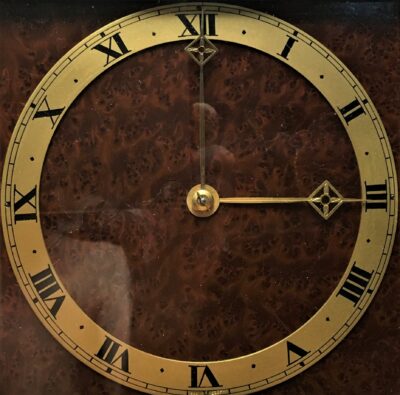Last Update: 07-25-2022 @ 02:55
4.03 – Running Time
The running time of a clock is the third point of view of the taxonomy. The source of its power limits its running time. Weight mechanical clocks seem limited by the time weights take to go down. The springs’ length and thickness seem to limit the working time of mechanical clocks. But it is more complicated than that. It’s a set of factors that determine mechanical clocks’ running time, including escapement, gears, and pendulum. In both cases, the minimum duration is 30 hours and eight days, except for most alarm clocks that run for 24 hours. Some spring clocks go up to 14 days, but most often, it’s 31 days. The exception is anniversary clocks that can run 400 or 1000 days without rewinding.
In theory, clocks connected to the alternating electric current should run all the time, but power outages happen. Battery-powered electric clocks work until exhausted. Finally, some clocks have a perpetual movement.
4.03.1 – Running Time of Weight Clocks
4.03.2 – Running Time of Mainspring Clocks
4.03.3 – Running Time of Electric Clocks
4.03.4 – Perpetual Running
Next: 4.04 – Alarms and Chimes



 Once winded, most mechanical alarm clocks lasted about 24 hours before rewinding. The Westclox Big Ben of the Western Clock Co. and its like, because there has been a lot of imitation, are 24 hours. Illustrated: a Big Ben Style 1a from the 1930s.
Once winded, most mechanical alarm clocks lasted about 24 hours before rewinding. The Westclox Big Ben of the Western Clock Co. and its like, because there has been a lot of imitation, are 24 hours. Illustrated: a Big Ben Style 1a from the 1930s. The standard running time of an American spring clock from the 18th and 19th centuries was generally 30 hours between rewinding, but so-called 8-day clocks could also be purchased as an option for the same model. Represented here a black mantle clock 30-hour Bim-Bam, E. Ingraham from 1929.
The standard running time of an American spring clock from the 18th and 19th centuries was generally 30 hours between rewinding, but so-called 8-day clocks could also be purchased as an option for the same model. Represented here a black mantle clock 30-hour Bim-Bam, E. Ingraham from 1929.  For a few more dollars, American consumers could buy a clock whose running time after a complete wind was a good week, like this black Greek temple-style mantle clock with its Corinthians columns, a Sessions from the early 1900s
For a few more dollars, American consumers could buy a clock whose running time after a complete wind was a good week, like this black Greek temple-style mantle clock with its Corinthians columns, a Sessions from the early 1900s 14-day clocks are not the norm. I have one in my collection. It’s a Monroe Bim-bam made in the USSR.
14-day clocks are not the norm. I have one in my collection. It’s a Monroe Bim-bam made in the USSR.



 On the same principle as the 400 days, here is a clock whose mainspring is very long to the point that it can work for almost three years. The movement itself is adjusted accordingly. It is a German Schatz from 1956, with a movement model 54.
On the same principle as the 400 days, here is a clock whose mainspring is very long to the point that it can work for almost three years. The movement itself is adjusted accordingly. It is a German Schatz from 1956, with a movement model 54. Here is an electric clock, a Telechron, model 4H99, which has a device to report a power outage. Look at the tiny red dot on the dial. When it appears, it means that the clock has lost its power. To make it disappear, you have to unplug and reconnect the clock or pulling the time adjustment button. It was a practical solution. Telechron obtained a patent for this device and sold licenses to several other manufacturers, including General Electric.
Here is an electric clock, a Telechron, model 4H99, which has a device to report a power outage. Look at the tiny red dot on the dial. When it appears, it means that the clock has lost its power. To make it disappear, you have to unplug and reconnect the clock or pulling the time adjustment button. It was a practical solution. Telechron obtained a patent for this device and sold licenses to several other manufacturers, including General Electric.


 Danny Hillis developed in 1986 the project of a clock that would operate continuously for 10,000 years. Three prototypes have been developed through the Long Now Foundation, one of which is on display at the Science Museum in London. Amazon CEO Jeff Bezos is one of the contributors to the construction of a 10,000-year-old mechanical clock, according to the Hills prototype. It will be 500 feet high and will be built in Texas on a site own by Bezos.
Danny Hillis developed in 1986 the project of a clock that would operate continuously for 10,000 years. Three prototypes have been developed through the Long Now Foundation, one of which is on display at the Science Museum in London. Amazon CEO Jeff Bezos is one of the contributors to the construction of a 10,000-year-old mechanical clock, according to the Hills prototype. It will be 500 feet high and will be built in Texas on a site own by Bezos. 
